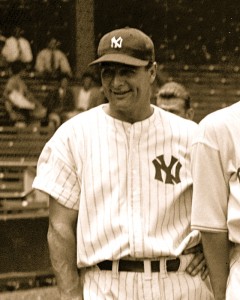On This Day: Lou Gehrig Speech
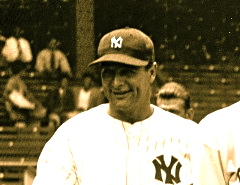
Lou Gehrig ESPN SportsCentury
I do not own this video and any media contained within it. All rights are given to the respective owners.
Gehrig (June 19, 1903 – June 2, 1941) was an American baseball first baseman who played 17 seasons in Major League Baseball (MLB) for the New York Yankees (1923–1939). Gehrig was renowned for his prowess as a hitter and for his durability, a trait which earned him his nickname “The Iron Horse.” He finished with a career batting average of .340, an on-base percentage of .447, and a slugging percentage of .632, and he tallied 493 home runs and 1,995 runs batted in (RBIs). A seven-time All-Star and six-time World Series champion, Gehrig won the Triple Crown in 1934 and was twice named the American League’s (AL) Most Valuable Player. Gehrig was the first MLB player to have his uniform number retired, and he was elected to the Baseball Hall of Fame in 1939.
A native of New York City and attendee of Columbia University, Gehrig signed with the Yankees in 1923. He set several major league records during his career, including the most career grand slams (23) (since broken) and most consecutive games played (2,130), a record that stood for 56 years and was long considered unbreakable until surpassed by Cal Ripken, Jr. in 1995. Gehrig’s streak ended in 1939 after he was stricken with amyotrophic lateral sclerosis (ALS), a disorder now commonly referred to as Lou Gehrig’s Disease in North America, which forced him to retire at age 36 and claimed his life two years later. The pathos of his farewell from baseball was capped off by his iconic “Luckiest Man on the Face of the Earth” speech at the original Yankee Stadium.
Gehrig was voted the greatest first baseman of all time by the Baseball Writers’ Association in 1969, and was the leading vote-getter on the Major League Baseball All-Century Team chosen by fans in 1999. A monument in Gehrig’s honor, originally dedicated by the Yankees in 1941, currently resides in Monument Park at Yankee Stadium. The Lou Gehrig Memorial Award, given annually to the MLB player best exhibiting the integrity and character of Gehrig, was named in the first baseman’s honor.
Early Life
Gehrig was born in the East Harlem neighborhood of Manhattan, weighing almost 14 pounds (6.4 kg) at birth. He was the second child out of four to German immigrants. His father Heinrich was a sheet metal worker by trade, but frequently unemployed due to alcoholism, and his mother Christina was a maid, the main breadwinner and disciplinarian in the family. His two sisters died from whooping cough and measles at an early age; a brother also died in infancy. Young Gehrig helped his mother with her work, doing tasks such as folding laundry and picking up supplies from the local stores. In 1910, Gehrig lived with his parents at 2266 Amsterdam Avenue in Washington Heights. In 1920, the family resided on 8th Avenue in Manhattan.
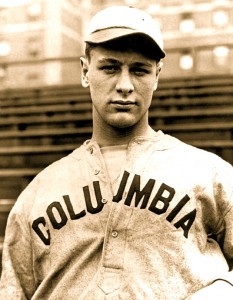 Gehrig on the Columbia University baseball team
Gehrig on the Columbia University baseball team
Gehrig first garnered national attention for his baseball ability while playing in a game at Cubs Park (now Wrigley Field) on June 26, 1920. Gehrig’s New York School of Commerce team was playing a team from Chicago’s Lane Tech High School, in front of a crowd of more than 10,000 spectators. With his team winning 8–6 in the top of the ninth inning, Gehrig hit a grand slam completely out of the major league park, an unheard-of feat for a 17-year old.
Lou Gehrig attended PS 132 in the Washington Heights section of Manhattan, then went to Commerce High School, graduating in 1921. Gehrig then studied at Columbia University for two years, although he did not graduate. While attending Columbia, he was a member of Phi Delta Theta fraternity. Initially, Gehrig went to Columbia on a football scholarship, where he was preparing to pursue a degree in engineering. However before his first semester, under the influence of New York Giants manager John McGraw, he was advised to play on a summer professional baseball team under a false name, Henry Lewis, despite the fact that it could jeopardize his collegiate sports eligibility. After only a dozen games played for the Hartford Senators in the Eastern League, he was discovered, and then banned from collegiate sports his freshman year. In 1922, Gehrig returned to the collegiate sport atmosphere where he was a talented fullback for the Lions football program. Later, in 1923, he would play first base and pitch for Columbia.
On April 18, 1923, the same day that Yankee Stadium opened for the first time and Babe Ruth inaugurated the new stadium with a home run, Columbia pitcher Gehrig struck out seventeen Williams College batters to set a team record; however, Columbia lost the game. Only a handful of collegians were at South Field that day, but more significant was the presence of Yankee scout Paul Krichell, who had been trailing Gehrig for some time. It was not Gehrig’s pitching that particularly impressed him; rather, it was Gehrig’s powerful left-handed hitting. During the time Krichell had been observing the young Columbia ballplayer, Gehrig had hit some of the longest home runs ever seen on various Eastern campuses, including a 450-foot (137 m) home run on April 28 at Columbia’s South Field, which landed at 116th Street and Broadway.[25] Within two months, Gehrig signed a Yankee contract. Gehrig returned to minor-league Hartford to play parts of two seasons, 1923 and 1924, batting .344 and hitting 61 home runs in 193 games. (It was the only time Gehrig ever played any level of ball—sandlot, high school, collegiate or pro—for a team based outside New York City.)
Major League Career – New York Yankees (1923-1939)
Gehrig joined the New York Yankees midway through the 1923 season and made his debut on June 15, 1923, as a pinch hitter. In his first two seasons, he saw limited playing time, mostly as a pinch hitter — he played in only 23 games and was not on the Yankees’ 1923 World Series roster. In 1925, he batted .295, with 20 home runs and 68 runs batted in (RBI’s).
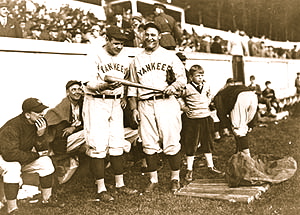 Babe Ruth and Lou Gehrig in exhibition game at West Point, New York (May 6, 1927)
Babe Ruth and Lou Gehrig in exhibition game at West Point, New York (May 6, 1927)
The 23-year-old Yankee first baseman’s breakout season came in 1926, when he batted .313 with 47 doubles, an American League-leading 20 triples, 16 home runs, and 112 RBI. In the 1926 World Series against the St. Louis Cardinals, Gehrig hit .348 with two doubles and 4 RBI’s. The Cardinals won a seven-game series four games to three.
1927
In 1927, Gehrig put up one of the greatest seasons by any batter in history, hitting .373, with 218 hits: 52 doubles, 18 triples, 47 home runs, a then-record 175 runs batted in (surpassing teammate Babe Ruth’s 171 six years earlier), and a .765 slugging percentage. His 117 extra-base hits that season are second all-time to Babe Ruth’s 119 extra-base hits in 1921 and his 447 total bases are third all-time, after Babe Ruth’s 457 total bases in 1921 and Rogers Hornsby’s 450 in 1922. Gehrig’s production helped the 1927 Yankees to a 110–44 record, the AL pennant, and a four-game sweep of the Pittsburgh Pirates in the 1927 World Series. Although the AL recognized his season by naming him league MVP, it was overshadowed by Babe Ruth’s 60 home run season and the overall dominance of the 1927 Yankees, a team often cited as having the greatest lineup of all time — the famed Murderers’ Row.
Despite playing in the shadow of the larger-than-life Ruth for two-thirds of his career, Gehrig was one of the highest run producers in baseball history: he had 509 RBI’s during a three-season stretch (1930–32). Only two other players, Jimmie Foxx with 507 and Hank Greenberg with 503, have surpassed 500 RBIs in any three seasons; their totals were non-consecutive. (Babe Ruth had 498.) Playing 14 complete seasons, Gehrig had 13 consecutive seasons with 100 or more RBIs (a major league record shared with Foxx until eclipsed in 2010 by Alex Rodriguez). Gehrig had six seasons where he batted .350 or better (with a high of .379 in 1930), plus a seventh season at .349. He had seven seasons with 150 or more RBI’s, 11 seasons with over 100 walks, eight seasons with 200 or more hits, and five seasons with more than 40 home runs. Gehrig led the American League in runs scored four times, home runs three times, and RBIs five times. His 184 RBIs in 1931 remain the American League record as of 2010 and rank second all-time to Hack Wilson’s 191 RBIs in 1930. On the single-season RBI list, Gehrig ranks second, fifth (175), and sixth (174), with four additional seasons over 150 RBI. He also holds the baseball record for most seasons with 400 total bases or more, accomplishing this feat five times in his career. He batted fourth in the lineup to Ruth’s third in the order, making it impractical to give up an intentional walk to Ruth.
During the 10 seasons (1925–1934) in which Gehrig and Ruth were both Yankees and played a majority of the games, Gehrig had more home runs than Ruth only once, in 1934, when he hit 49 compared to Ruth’s 22 (Ruth played 125 games that year). They tied at 46 in 1931. Ruth had 424 home runs compared to Gehrig’s 347. However, Gehrig outpaced Ruth in RBI, 1,436 to 1,316. Gehrig had a .343 batting average, compared to .338 for Ruth.
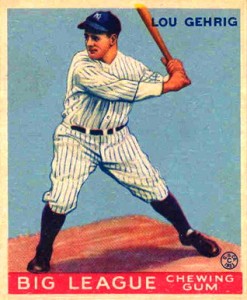 Gehrig 1933 Goudey baseball card.
Gehrig 1933 Goudey baseball card.
1932
In 1932, Gehrig became the first player of the 20th century to hit four home runs in a game, accomplishing the feat on June 3 against the Philadelphia Athletics. He narrowly missed getting a fifth home run in the game when Athletics center fielder Al Simmons made a leaping catch of another fly ball at the center field fence. After the game, manager Joe McCarthy told him, “Well, Lou, nobody can take today away from you.” On the same day, however, John McGraw announced his retirement after thirty years of managing the New York Giants. McGraw, not Gehrig, got the main headlines in the sports sections the next day. The following year, in September 1933, Gehrig married Eleanor Twitchell, the daughter of Chicago Parks Commissioner Frank Twitchell.
1936
In a 1936 World Series cover story about Lou Gehrig and Carl Hubbell, Time proclaimed Gehrig “the game’s No. 1 batsman,” who “takes boyish pride in banging a baseball as far, and running around the bases as quickly, as possible.”
Also in 1936, pushed by his wife, Gehrig agreed to hire Babe Ruth’s agent, who in turn, pushed the Iron Horse to audition for the role of the Ape Man, Tarzan, after Johnny Weissmuller had vacated the iconic movie role. But Gehrig only got as far as posing for a widely distributed, and embarrassing, photo of himself in a leopard-spotted costume. When Tarzan creator Edgar Rice Burroughs spotted the outfit, he diplomatically telegrammed Lou: “I want to congratulate you on being a swell first baseman.”
2,130 consecutive games
On June 1, 1925, Gehrig entered the game as a pinch hitter, substituting for shortstop Paul “Pee Wee” Wanninger. The next day, June 2, Yankee manager Miller Huggins started Gehrig in place of regular first baseman Wally Pipp. Pipp was in a slump, as were the Yankees as a team, so Huggins made several lineup changes to boost their performance, replacing Pipp, Aaron Ward, and Wally Schang. Fourteen years later, Gehrig had played 2,130 consecutive games.
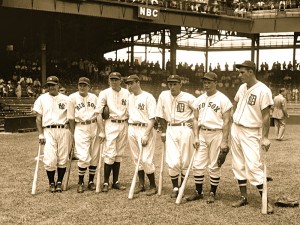 Seven of the American League’s 1937 All-Star players, from left to right Lou Gehrig, Joe Cronin, Bill Dickey, Joe DiMaggio, Charlie Gehringer, Jimmie Foxx and Hank Greenberg. All seven would eventually be elected to the Hall of Fame.
Seven of the American League’s 1937 All-Star players, from left to right Lou Gehrig, Joe Cronin, Bill Dickey, Joe DiMaggio, Charlie Gehringer, Jimmie Foxx and Hank Greenberg. All seven would eventually be elected to the Hall of Fame.
In a few instances, Gehrig managed to keep the streak intact through pinch hitting appearances and fortuitous timing; in others, the streak continued despite injuries. For example:
On April 23, 1933, a pitch by Washington Senators pitcher Earl Whitehill struck Gehrig in the head. Although almost knocked unconscious, Gehrig remained in the game.
On June 14, 1933, Gehrig was ejected from a game, along with manager Joe McCarthy, but he had already been at bat and received credit for playing the game.
In a June, 1934 exhibition game, Gehrig was hit by a pitch, just above the right eye and was knocked unconscious. According to news reports, he was out for five minutes. Helmets were not heavily introduced until the 1940’s. He left the game, but was in the lineup the next day.
On July 13, 1934, Gehrig suffered a “lumbago attack” and had to be assisted off the field. In the next day’s away game, he was listed in the lineup as “shortstop,” batting lead-off. In his first and only plate appearance, he singled and was promptly replaced by a pinch runner to rest his throbbing back, never taking the field. A&E’s Biography speculated that this illness, which he also described as “a cold in his back,” might have been the first symptom of his debilitating disease.
In addition, X-rays taken late in his life disclosed that Gehrig had sustained several fractures during his playing career, although he remained in the lineup despite those previously undisclosed injuries. On the other hand, the streak was helped when Yankees general manager Ed Barrow postponed a game as a rainout on a day when Gehrig was sick with the flu—even though it was not raining.
Gehrig’s record of 2,130 consecutive games played stood until September 6, 1995, when Baltimore Orioles shortstop Cal Ripken, Jr. broke it.
Illness
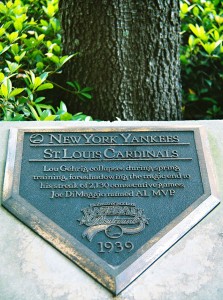 Plaque in St. Petersburg, Florida, where Gehrig collapsed in 1939 during spring training
Plaque in St. Petersburg, Florida, where Gehrig collapsed in 1939 during spring training
Although his performance in the second half of the 1938 season was slightly better than in the first half, Gehrig reported physical changes at the midway point. At the end of that season, he said, “I tired mid-season. I don’t know why, but I just couldn’t get going again.” Although his final 1938 statistics were above average (.295 batting average, 114 RBI, 170 hits, .523 slugging percentage, 689 plate appearances with only 75 strikeouts, and 29 home runs), they were significantly down from his 1937 season, in which he batted .351 and slugged .643. In the 1938 World Series, he had four hits in 14 at-bats, all singles.
When the Yankees began their 1939 spring training in St. Petersburg, Florida, it was clear that Gehrig no longer possessed his once-formidable power. Even Gehrig’s base running was affected, and at one point he collapsed at Al Lang Field, then the Yankees’ spring training park. By the end of spring training, Gehrig had not hit a home run. Throughout his career, Gehrig was considered an excellent baserunner, but as the 1939 season got under way, his coordination and speed had deteriorated significantly.
By the end of April, his statistics were the worst of his career, with one RBI and a .143 batting average. Fans and the press openly speculated on Gehrig’s abrupt decline. James Kahn, a reporter who wrote often about Gehrig, said in one article:
I think there is something wrong with him. Physically wrong, I mean. I don’t know what it is, but I am satisfied that it goes far beyond his ball-playing. I have seen ballplayers ‘go’ overnight, as Gehrig seems to have done. But they were simply washed up as ballplayers. It’s something deeper than that in this case, though. I have watched him very closely and this is what I have seen: I have seen him time a ball perfectly, swing on it as hard as he can, meet it squarely — and drive a soft, looping fly over the infield. In other words, for some reason that I do not know, his old power isn’t there… He is meeting the ball, time after time, and it isn’t going anywhere.
He was indeed meeting the ball, with only one strikeout in 28 at-bats; however, Joe McCarthy found himself resisting pressure from Yankee management to switch Gehrig to a part-time role. Things came to a head when Gehrig had to struggle to make a routine put-out at first base. The pitcher, Johnny Murphy, had to wait for Gehrig to drag himself over to the bag so he could field the throw. Murphy said, “Nice play, Lou.”
On April 30, Gehrig went hitless against the Washington Senators. Gehrig had just played his 2,130th consecutive major league game.
On May 2, the next game after a day off, Gehrig approached McCarthy before the game in Detroit against the Tigers and said, “I’m benching myself, Joe,” telling the Yankees’ skipper that he was doing so “for the good of the team.” McCarthy acquiesced, putting Ellsworth “Babe” Dahlgren in at first base, and also said that whenever Gehrig wanted to play again, the position was his. Gehrig himself took the lineup card out to the shocked umpires before the game, ending the fourteen-year streak. Before the game began, the Briggs Stadium announcer told the fans, “Ladies and gentlemen, this is the first time Lou Gehrig’s name will not appear on the Yankee lineup in 2,130 consecutive games.” The Detroit Tigers’ fans gave Gehrig a standing ovation while he sat on the bench with tears in his eyes. A wire service photograph of Gehrig reclining against the dugout steps with a stoic expression appeared the next day in the nation’s newspapers. Gehrig stayed with the Yankees as team captain for the rest of the season, but never played in a major league game again.
Diagnosis
As Lou Gehrig’s debilitation became steadily worse, his wife, Eleanor, called the famed Mayo Clinic in Rochester, Minnesota. Her call was transferred to Charles William Mayo, who had been following Gehrig’s career and his mysterious loss of strength. Mayo told Eleanor to bring Gehrig as soon as possible.
Gehrig flew alone to Rochester from Chicago, where the Yankees were playing at the time, arriving at the Mayo Clinic on June 13, 1939. After six days of extensive testing at Mayo Clinic, the diagnosis of amyotrophic lateral sclerosis (ALS) was confirmed on June 19, Gehrig’s 36th birthday. The prognosis was grim: rapidly increasing paralysis, difficulty in swallowing and speaking, and a life expectancy of less than three years, although there would be no impairment of mental functions. Eleanor Gehrig was told that the cause of ALS was unknown but it was painless, non-contagious and cruel — the motor function of the central nervous system is destroyed but the mind remains fully aware to the end.
He often wrote letters to Eleanor, and in one such note written shortly afterwards, said (in part):
“The bad news is lateral sclerosis, in our language chronic infantile paralysis. There isn’t any cure… there are very few of these cases. It is probably caused by some germ…Never heard of transmitting it to mates… There is a 50–50 chance of keeping me as I am. I may need a cane in 10 or 15 years. Playing is out of the question…”
Following Gehrig’s visit to the Mayo Clinic, he briefly rejoined the Yankees in Washington, D.C. As his train pulled into Union Station, he was greeted by a group of Boy Scouts, happily waving and wishing him luck. Gehrig waved back, but he leaned forward to his companion, a reporter, and said, “They’re wishing me luck — and I’m dying.”
In 2012, some Minnesota State legislators sought to unseal Lou Gehrig’s medical records, which are held by the Mayo Clinic, in an effort to see if Gehrig’s ALS had any connection with concussion-related trauma he received during his career.
Retirement
 Lou Gehrig’s number 4 was retired by the New York Yankees in 1939.
Lou Gehrig’s number 4 was retired by the New York Yankees in 1939.
On June 21, the New York Yankees announced Gehrig’s retirement. The doctors of the Mayo Clinic had released his ALS diagnosis to the public on June 19. There was then a public push to honor Gehrig. The idea of an appreciation day reportedly began with Bill Hirsch, a friend of sports columnist Bill Corum. Corum spoke of the idea in his column, and other sportswriters picked up on the idea, promoting it far and wide in their respective periodicals. Someone suggested the appreciation day be held during the All-Star Game, but when Yankees owner Ed Barrow got a hold of the idea, he quickly shot down the All-Star Game suggestion. He didn’t want Gehrig to share the spotlight with any other all-star. Believing the idea was valid and the best thing to do, he wanted the appreciation day to be soon, and the Yankees proclaimed July 4, 1939, “Lou Gehrig Appreciation Day” at Yankee Stadium. Between games of the Independence Day doubleheader against the Washington Senators, the poignant ceremonies were held on the diamond.
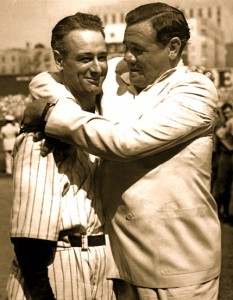 The Yankee duo reunited – Lou Gehrig and Babe Ruth at Yankee Stadium on July 4, 1939. Within a decade a similar testimonial would honor Ruth, who died from cancer in 1948.
The Yankee duo reunited – Lou Gehrig and Babe Ruth at Yankee Stadium on July 4, 1939. Within a decade a similar testimonial would honor Ruth, who died from cancer in 1948.
In its coverage the following day, The New York Times said it was “perhaps as colorful and dramatic a pageant as ever was enacted on a baseball field [as] 61,808 fans thundered a hail and farewell.” Dignitaries extolled the dying slugger and the members of the 1927 Yankees World Series team, known as “Murderer’s Row,” attended the ceremonies. New York Mayor Fiorello La Guardia called Gehrig “the greatest prototype of good sportsmanship and citizenship” and Postmaster General James Farley concluded his speech by predicting, “For generations to come, boys who play baseball will point with pride to your record.”
Yankees Manager Joe McCarthy, struggling to control his emotions, then spoke of Lou Gehrig, with whom he had a close, almost father-and-son–like bond. After describing Gehrig as “the finest example of a ballplayer, sportsman, and citizen that baseball has ever known,” McCarthy could stand it no longer. Turning tearfully to Gehrig, the manager said, “Lou, what else can I say except that it was a sad day in the life of everybody who knew you when you came into my hotel room that day in Detroit and told me you were quitting as a ballplayer because you felt yourself a hindrance to the team. My God, man, you were never that.”
The Yankees retired Gehrig’s uniform number “4,” making him the first player in Major League Baseball history to be accorded that honor. Gehrig was given many gifts, commemorative plaques, and trophies. Some came from VIPs; others came from the stadium’s groundskeepers and janitorial staff. Footage of the ceremonies shows Gehrig being handed various gifts, and immediately setting them down on the ground, because he no longer had the arm strength to hold them. The Yankees gave him a silver trophy with their signatures engraved on it. Inscribed on the front was a special poem written by The New York Times writer John Kieran. The trophy cost only about $5, but it became one of Gehrig’s most prized possessions. It is currently on display at the National Baseball Hall of Fame and Museum.
“The Luckiest Man on the Face of the Earth”
After the presentations and remarks by Babe Ruth, Gehrig addressed the crowd:
“Fans, for the past two weeks you have been reading about the bad break I got. Yet today I consider myself the luckiest man on the face of the earth. I have been in ballparks for seventeen years and have never received anything but kindness and encouragement from you fans.”
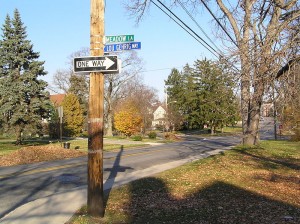 Lou Gehrig Way in New Rochelle, NY
Lou Gehrig Way in New Rochelle, NY
Look at these grand men. Which of you wouldn’t consider it the highlight of his career just to associate with them for even one day? Sure, I’m lucky. Who wouldn’t consider it an honor to have known Jacob Ruppert? Also, the builder of baseball’s greatest empire, Ed Barrow? To have spent six years with that wonderful little fellow, Miller Huggins? Then to have spent the next nine years with that outstanding leader, that smart student of psychology, the best manager in baseball today, Joe McCarthy? Sure, I’m lucky.
When the New York Giants, a team you would give your right arm to beat, and vice versa, sends you a gift—that’s something. When everybody down to the groundskeepers and those boys in white coats remember you with trophies—that’s something. When you have a wonderful mother-in-law who takes sides with you in squabbles with her own daughter—that’s something. When you have a father and a mother who work all their lives so that you can have an education and build your body—it’s a blessing. When you have a wife who has been a tower of strength and shown more courage than you dreamed existed—that’s the finest I know.
So I close in saying that I might have been given a bad break, but I’ve got an awful lot to live for. Thank you.
—Lou Gehrig at Yankee Stadium, July 4, 1939—
The crowd stood and applauded for almost two minutes. Gehrig was visibly shaken as he stepped away from the microphone, and wiped the tears away from his face with his handkerchief. Babe Ruth came over and hugged him as a band played “I Love You Truly” and the crowd chanted “We love you, Lou.” The New York Times account the following day called it “one of the most touching scenes ever witnessed on a ball field”, that made even hard-boiled reporters “swallow hard.”

